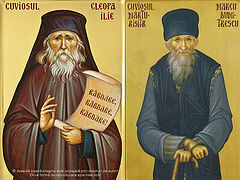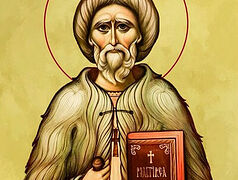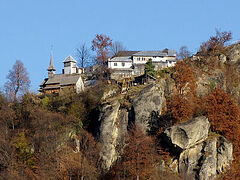Poiana Marului: The Second Athos
 Poiana Marului Monastery and its environs This is the undisputed foundation of St. Basil, the year 1730… However, it’s already evening, the river has completely overflowed its banks, and there’s no way for me to get across it. The Râmnicul, a river almost bordering the monastery mountain, rises before me as a kind of boundary before the higher worlds, allowing you to go there only when you’re destined to do so.
Poiana Marului Monastery and its environs This is the undisputed foundation of St. Basil, the year 1730… However, it’s already evening, the river has completely overflowed its banks, and there’s no way for me to get across it. The Râmnicul, a river almost bordering the monastery mountain, rises before me as a kind of boundary before the higher worlds, allowing you to go there only when you’re destined to do so.
The next day, we’re back in the village of Jitia, in a village shop on the river bank, looking for the gypsy coachman who promised to take us across the river by fording. The waves reach up to the chest of his poor horses, who struggle with all their might to hold their balance on slippery underwater rocks. And then they start trotting through the mud, tossing us up on potholes and deafeningly rumbling the wagon along a steep road, seemingly piercing the very sky.
It’s amazing what a distance St. Basil’s monks covered on foot then! The monasteries of Dalhauti and Poiana Marului were considered almost one whole, one community with one abbot, and the saint made this journey hundreds of times, which today can hardly be made by car, taking several hours. He often went around to other monasteries in the mountains, all of them founded by him, built by him, to check their strict regulations and to instruct the monks.
What a confluence of monks there was in the eighteenth century around the famous Poiana Marului! At least eleven monasteries were spiritually nurtured and headed by Abbot Basil in the mountains of Vrancea and Buzău —he’s a rare case in the history of hesychasm. Dalhauti, Ciolanu, Rătești , Rogoz, Bontaști, Trăisteni, Găvanu , Fundătura, Cârnu, Valea Neagră—all of these now famous monasteries are his work. They were inhabited only by disciples brought up by him—Romanians and Russians—united in this hotbed of hesychasm, which was then known throughout the world as the “Second Athos.”
Poinana Marului Monastery is a genuine, gigantic wooden fortress. Wood! Many blackened trees, shaped into some kind of fairy-tale, unearthly constructions. This church is the largest and most complex wooden building I’ve ever seen. An intricate Russian structure made of long logs, crowned with an abundance of giant heads, like a phantasmagoric plank spaceship that landed here among the meadow’s yellow flowers.
The monastery’s a little empty, and it’s been this way for a few months already. Just one young monk and four nuns live here, and the faithful don’t particularly come here. It’s been that way since the Bishop of Vrancea and Buzău expelled Fr. Macarie (Beshliou), who restored the monastery after the communists and who was endlessly loved by thousands of people. There were many fierce conflicts, and they even talked about some kind of curse, trampling on the testament left by St. Basil in 1764, where he threatened anathema upon anyone who dared to violate the Athonite order of his monasteries and to bring nuns here instead of monks.
 Iconostasis in the ancient Church of All Saints at Poiana Marului Skete, 1730
Iconostasis in the ancient Church of All Saints at Poiana Marului Skete, 1730
This was encroached upon less than a year ago (in 2010). Fr. Macarie was forcibly sent to the remote Muntioru Skete, and in his place they brought these fourpoor nuns and the young Hieromonk Dionisie from Ciolanu Monastery—these innocent monastics. The new father greets me silently, with downcast eyes, and only then asks if I came “in connection with the scandal.” Uncomplaining, he’s ready to tell me, like many others, that there’s nothing left for him to do, that he was sent here by the bishop on obedience, and a monk should obey. He even marvels, hearing that I didn’t come for that.
Of course, he shows me the monastery, tells me everything he knows about St. Basil, but he hasn’t been here long, and I should be understanding… He might have even wanted to leave, given the conflict, which makes it hard for a monk to live. Indeed, he might have left. Had it not been for the icon of St. Basil he saw when he first came here a year ago.
“The icon changed my life. A saint with his arms folded over his chest, which indicates the prayer of the heart. I didn’t know what it was then. Just the sight of the icon? Or that it’s here in such a blessed place? I don’t know. But from August, when I saw it, until November, when I moved here, this icon was ever before my eyes, wherever I went. Always, always. It was following me, calling me. I started reading about this saint, and I came here and asked if anything else was known about him—what books he wrote, whether we have his relics. I was ordained on November 15, on the feast of St. Paisius (Velichkovsky), a disciple of St. Basil of Poiana Marului. And on November 15, exactly a year later, I was called here.
I also look at the icon to the right of the altar. St. Basil—indeed one of the most “spiritualized” Romanian saints whose icon I’ve seen. An ascetic, just skin and bones, and pretty tall, apparently. Eyes above prominent cheekbones looking at me with touching meekness and pity, as if stemming from self-pity.
He reposed in this monastery in 1767, but out of humility he wanted the place of his burial to be kept secret, and he even indicated this in his will. But the monks saw a supernatural light at night, coming from an old cross in the grass behind the altar.
Open-air academy
It’s already become a custom: On summer evenings, Fr. Dionisie and the nuns sit on the grass and watch as the pearly rays of the moon bathe the fantastic dark building of the church. Unreal, gloomy, as if from another world.
Everyone looks and thinks about what happened here long ago. There’s so much antiquity and holiness in this place that the young priest can’t speak about it without trembling.
He realized this only when he had lived there for a while. He shows me a recently published book by the Italian theologian Dario Raccanello—praiseworthy words offered by Christian scholars and residents of this monastery for Elder Basil and the Romanian spirituality of the eighteenth century. Hundreds of pages full of admiration, and everything is entirely about Vrancea, Buzău, and Poiana Marului:
“ The ancient hesychastic tradition is here, rooted in the very origins of Christianity and still alive today.”
“The powerful philokalic Romanian current of prayer has shone throughout the entire Christian world.”
“St. Basil is the deepest expert in ascetic Byzantine literature and spirituality of his time.”
“No Romanian skete had such an impact on the spiritual cultural sphere as did Poiana Marului,” and so on.
This was written by foreigners. And we write insultingly little about it. The Italian author is continually perturbed by the fact that “the figure of St. Basil hasn’t become a subject of research in Romanian theological literature, and in Romanian Orthodox Church history books, the name of our Elder from Poinana Marului is mentioned only in passing.”
 Interior of the little Church of the Nativity of the Most Holy Theotokos at Poiana Marului Skete, 1812
Interior of the little Church of the Nativity of the Most Holy Theotokos at Poiana Marului Skete, 1812
Foreigners admire our history and reproach us for not valuing our treasure as we should. They speak of this monastery as “a great European cultural center,” “a unique phenomenon,” asserting that “rarely is there found a hermitage like the one at Poiana Marului, which in just a hundred years of existence has left such a deep impact on religious literature.”
Here, in the desert of the Vrancea Mountains, in the time of St. Basil, there was a prestigious library and a “scriptorium”—a workshop for copying manuscripts, from which came many copies of invaluable manuscripts. They were produced by venerable scribes who labored tirelessly day and night. Translation specialists, learned monks, educated at the European level, spiritual people, outstanding intellectuals once labored in these forests. And St. Basil of the Carpathians watched over all of them for thirty-seven years.
Here, on the grass, in those ancient times, monks gathered around their spiritual father, who “used to sit on the green grass by the church, under the trees that grew around the monastery, and then brethren would come and sit next to the Elder, who would begin to teach them and answer their questions.”
St. Paisius (Velichkovsky), a disciple of Elder Basil, recalls that these meetings, called, “soul-profiting conversations,” had hundreds of monks, who sat on the grass, “being sated with the spiritual honey dripping from the lips of their guide Basil.” A true open-air theological academy operated in Poiana Marului, where an incredibly powerful spirit of prayer reigned. In this community, which Church chronicles of those times called “wondrous,” the monks abode in perfect harmony and obedience, loving silence, humility, and material poverty, and faithfully following the rules of their Elder: no meat, no glasses of wine. And they kept a strict fast, except on Saturdays and Sundays, and always without milk products. There were daily readings of the Holy Scriptures. But the most important thing was the work of the unceasing prayer of the heart, its constant utterance in the mind according to certain “techniques.” All of this formed the “true course of the renewal of hesychastic monasticism throughout the world.”
St. Basil was considered “the most famous hesychast of Romania. The first teacher of noetic prayer in the Orthodox East of modern times, since from a chronological point of view, St. Paisius (Velichkovsky) and St. Nikodemos of the Holy Mountain follow after him,” as the famous Greek scholar Paisios Taxiaos specifies. This is what Elder Basil from Poiana Marului is known for in history—the science of praying those seven words: “Lord, Jesus Christ, have mercy on me.”
He had only seven—without “Son of God,” and without, “a sinner.” That’s all! And after that, there’s just Paradise.
Elder Macarie of Muntioru
I still had to meet with Fr. Macarie (Beshliou), “the second Basil of Poiana Marului,” as the faithful call him, in his Muntioru Skete on the top of the mountains, where he was exiled. I also had to get there by horse-drawn cart, but the road turned out to be much more difficult—it was pouring rain, the mud was knee-deep, the climb took two hours, and twice I nearly said goodbye to life.
Fr. Macarie is a spiritual father with a peasant streak—savvy, with strands of gray hair and a high forehead. Elder Cleopa himself kissed his hand, saying he was “glad to see the one whom St. Basil chose as abbot of his monastery.” It was he who in an amazingly short time prepared the canonization of St. Basil in 2003, at which fifteen hierarchs and 150 priests served. It was he who once, after a summertime Midnight Office, together with other witnesses, saw in Poiana Marului “at half-past one in the morning a light coming from the cross on one of the graves next to the church; not from flames, not golden, but soft, shining ten to twelve feet around the cross.”
This cross stands in the grass behind the altar, and many think that the relics of the Vrancea saint rest under it. But the young Dionisie knows it can’t be. And his predecessor, Fr. Macarie, also can’t confirm it. In any case, it’s impossible to excavate there, because the saint himself didn’t want it, as he wrote in his testament, which means there are no grounds for exhumation.
And yet the young Fr. Dionisie always feels that St. Basil is near. How? He can’t explain it. By some kind of spirit, hovering over this garden, strewn with varieties of apples that don’t grow anywhere else in the country, especially at such high altitudes… By this gilded icon to the right of the iconostasis, which although quite new, changed his fate once… By these seven words, which he ceaselessly repeats in his mind, trying not to interrupt their thread, not to distort them with the rhythm of his breathing; words he repeats, even when he’s speaking with me, with his nuns, young and timid about such a great mission; when he labors in the garden, and when he wanders among the flowers on Sunday, expecting that people will start coming to church again in ever-increasing numbers, returning to this blessed place, which can’t be forgotten. Incessantly, those same seven words,resounding in his mind, like a distant bell: “Lord Jesus Christ, have mercy on me.”
Seven words. That’s it. And after that, only Paradise.








